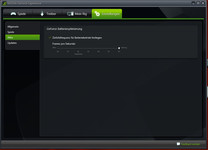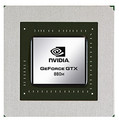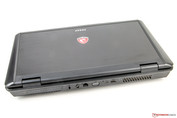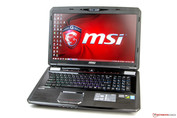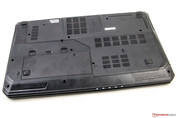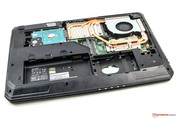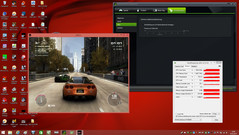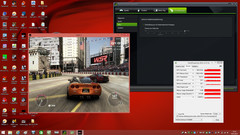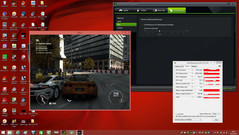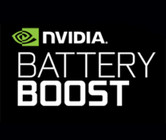Nvidia Battery Boost Review

For the original German article, see here.
Technology
With the current GeForce GTX 800M series Nvidia not only drives its graphics units to new performance heights, but also wants to improve the mobile gaming experience by enabling acceptable runtimes even when there is no socket within reach. To do so the US company developed software control called Battery Boost.
The software is part of the Nvidia GeForce Experience and is hidden in the settings under Battery. The configuration is kept simple. It can be turned either on or off. Additionally the user can decide to which frame rate he wants to limit the supported games.
This is the trick to save energy. The performance potential of the respective graphics unit is adjusted in a way that reaches the predefined number of frames. According to Nvidia, titles that are displayed at 70 to 80 fps are better suited, since a system that is already maxed out at 30 fps has only a small potential for savings. In the case that the display is in danger of stuttering, the system should increase the performance independently. We tested with various games how this works out in practice.
Test System
As a test system we deployed the MSI GT70 2PE-890US, which was kindly provided to us by Nvidia Germany for gaming tests. Besides an Intel Core i7-4800MQ processor, which clocks between 2.7 and 3.7 GHz, the laptop offers 12 GB DDR main memory. With the Nvidia GeForce GTX 880M it has the most powerful single graphics solution on board that can be acquired for notebooks at the moment.
The GPU is a GK104 Kepler chip and does not rely on the current Maxwell architecture yet. A mighty 8 GB GDDR5 memory and a 256-bit memory interface are on board. The system promises a lot of power and has demonstrated its abilities in our extensive review. Only a few titles are currently capable of bringing the system to its limits. The operating system was Microsoft Windows 8.1 (update 1) 64-bit. The storage device was a 1000 GB HDD, which turns at 7,200 rpm.
Test configuration:
- Intel HM87 Chipset (Lynx Point)
- Intel Core i7-4800MQ (Quad-Core, up to 3.7 GHz)
- 4 + 8 GB DDR3-RAM (1600 MHz, dual-channel)
- Nvidia GeForce GTX 880M Kepler (ForceWare 332.35)
- HGST Travelstar 7K1000 HTS721010A9E630 (1,000 GB, 7,200 rpm)
- Microsoft Windows 8.1 (Update 1) 64-bit
Grid 2

The car racing game Grid 2 provides the best possible test candidate. Even with ultra preset (1920x1080 pixels, maximum details, 4x MSAA) it runs very smoothly with an average of 72.6 fps and thus lies in Nvidia's suggested ideal range to use the Battery Boost technology.
Another advantage to drain the battery as consistently as possible is the integrated benchmark. It can be executed in a loop so that a similar energy demand can be expected for all test runs. In every game cycle the power plan of the MSI GT70 2PE-890US is set to Balanced. Additionally, the brightness of the panel is adjusted to 150 cd/m² and the backlight of the keyboard deactivated.
First we determined the runtime of the gaming notebook without Battery Boost. In this case, the system achieves a runtime of 45 minutes. Next up was the first test with activated battery optimization with an image refresh rate of 50 fps. The runtime increases to 51 minutes and is thus about 13 percent higher. 30 fps is recommended to attain both a smooth gaming experience and the highest possible runtime. With this setting, the performance is increased once again and allows the benchmark to run for 56 minutes. Therefore, the endurance of the system is improved by up to 25 percent. However, we are still far from the promised doubling in runtime.
Due to its continuous workload the title is perfect for having a look at the clock frequency of the Nvidia GeForce GTX 880M. In power supply mode the GeForce GTX 880M runs at about 993 MHz core and 2,500 MHz memory clock and thus achieves on average 72 fps during the benchmark. In battery mode and a limit of 50 fps, the average frame rate drops to 54 fps. When the Battery Boost is set to 30 fps, there are still 45 fps displayed. The core clock still lies in the turbo range of the GPU and usually operates at 967 MHz, but also fluctuates in each sequence in both directions. In the stricter energy-saving mode, the clock drops to 914 MHz intermittently, but most of the time lies at the same level as in the more powerful mode.
The memory clock is also lowered when the notebook is taken off the grid and decreases to almost 2,000 MHz. However, this does not explain the slightly improved runtimes since the clock reductions also occur without activated Battery Boost. It is quite possible that the engineers of MSI preempted Nvidia in this case and thus the effect of the Battery Boost is lessened. Furthermore, it is apparent that the clock of the GPU is primarily lowered in the menus and drops partially below 800 MHz. In power-supply mode, the 880M runs once again with its entire 992 MHz. The processor performance is not affected by the battery optimization. We could not discover any differences in any of the tested games.
Starcraft 2 - Heart of the Swarm

Another game, with which we examined the battery optimization, is the real time strategy hit Starcraft 2 - Heart of the Swarm. The game's performance is considerably lower than the recommended frame rate by Nvidia. In ultra preset (1920x1080 pixels, extreme details, AA activated) the MSI GT70 reaches no more than 47 fps. Although it runs very smoothly, there is not much space left for the Battery Boost. The parameters (display 150 cd/m², keyboard backlight off, power plan Balanced) are the same as those of Grid 2.
First we checked the runtime without the battery optimization. We were able to play for 54 minutes straight before the notebook turned itself off. At a frame limit of 30 fps the gaming time was only extend by 3 minutes and thus reached 57 minutes, which is the equivalent of almost six percent. Given the small buffer, we would not have expected anything else. This time you can easily go without the Battery Boost, especially since we experienced stuttering when big troop formations were displayed.
Fifa 14

With the football simulation FIFA 14 we have a game that attains enormously high frame rates. This time there is no excuse for the Battery Boost because the MSI GT70 2PE-890US is able to speed up the game in ultra preset (1920x1080 pixels, maximum details, 4x MSAA) to 294 frames per second. Once again, we use the same parameters (display 150 cd/m², keyboard backlight off, power plan Balanced) as with the other two titles.
Without activated Battery Boost, the game achieves a runtime of 44 minutes. It would be difficult to play even half a game with that. Afterwards we directly conducted a test run with a reduced image refresh rate of 30 fps. FIFA 14 cannot be played under these circumstances. At first, the ball rolled smoothly across the virtual green, but after only a few minutes of play we experienced heavy stuttering. When we paused the game and went back to the menu, the game worked again for a minute. However, in the long run this was no solution, therefore we terminated the test.
We had another go with a frame rate limit of 50 fps. Once again we witnessed intermittent stuttering, but this time very attenuated. After ten minutes, the phenomenon vanished completely and FIFA 14 ran smoothly. Nvidia offers an automatic performance adjustment to allow a smooth gaming experience. It is quite possible that it took the software a few moments until it had leveled out at the optimum. Eventually the battery was drained once again, but this time it took 98 minutes. In this case, the Battery Boost extended the runtime by 122 percent and therefore even surpassed the promised doubling in runtime.
Verdict
With the Battery Boost technology of the current GTX 800M series Nvidia offers improved runtimes for games that are supported by the software GeForce Experience. With its aid, doubling the runtime should be possible and gaming truly mobile. This, however, is not the case for all titles.
Since the technology works by limiting the frame rate and therefore reducing the power required, it especially makes sense for games with high image refresh rates. The deployed test system is already one of the most powerful available on the market when only using a single GPU solution. However, those who do not want to lower the display quality usually do not have enough leeway to reduce the frame rate appropriately. Starcraft 2 is a good example since the runtime was improved by a meager 6 percent. Games like Starcraft 2 and Grid 2 stress the CPU quite heavily as well. However, the processor shows no performance impairments in the Battery Boost mode.
With FIFA 14, we also tested a game whose demands are not particularly high and therefore it reached high frame rates. This time the runtime was easily doubled. In return, it took a while until the football simulation ran smoothly. This calls for some fine-tuning on behalf of Nvidia.
Using Battery Boost for current 3D shooters like Battlefield 4 or Metro: Last Light makes no sense since frame rates simply become too low. Nevertheless, those who are willing to lower their settings on the go can achieve noticeably longer runtimes. All in all Nvidia's Battery Boost is a sensible feature that allows playing some games when on the move without the need of a socket.




